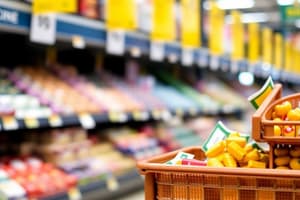Podcast
Questions and Answers
Which statement best describes the "law of demand"? Other things being equal, the quantity of tennis rackets demanded will be greater if the
Which statement best describes the "law of demand"? Other things being equal, the quantity of tennis rackets demanded will be greater if the
- incomes of tennis players are higher.
- price of tennis rackets is lower. (correct)
- demand for tennis rackets rises.
- number of tennis players is higher.
- price of badminton rackets is higher.
Consider a negatively sloped demand curve for natural gas. If the supply of natural gas increases, the new equilibrium will have
Consider a negatively sloped demand curve for natural gas. If the supply of natural gas increases, the new equilibrium will have
- the same price and larger quantity.
- a lower price and a greater quantity. (correct)
- a lower price and a smaller quantity.
- a higher price and a larger quantity.
- a higher price and a smaller quantity.
Refer to Table 32-5. The comparative advantage in cheese is held by
Refer to Table 32-5. The comparative advantage in cheese is held by
- Portugal.
- both countries.
- Insufficient information to know.
- neither country.
- Spain. (correct)
Which of the following illustrates elastic demand?
Which of the following illustrates elastic demand?
Normal goods
Normal goods
Suppose that the free-market equilibrium price of natural gas would be $2.00 per unit, but in an effort to protect consumers the government has fixed the price at $1.50. At this ceiling price the quantity ______ will be greater than the quantity ______ resulting in a ______ of natural gas.
Suppose that the free-market equilibrium price of natural gas would be $2.00 per unit, but in an effort to protect consumers the government has fixed the price at $1.50. At this ceiling price the quantity ______ will be greater than the quantity ______ resulting in a ______ of natural gas.
Economists use the term "marginal utility" to describe the
Economists use the term "marginal utility" to describe the
Any consumption point that is on the budget line
Any consumption point that is on the budget line
Refer to Table 7-4. The marginal product of labour is at its maximum when the firm changes the amount of labour hired from
Refer to Table 7-4. The marginal product of labour is at its maximum when the firm changes the amount of labour hired from
A short-run average total cost curve and a long-run average cost curve are tangent
A short-run average total cost curve and a long-run average cost curve are tangent
Any firm's average revenue is defined as
Any firm's average revenue is defined as
Suppose a typical firm in a competitive industry has the following data in the short run; price = $10; output = 100 units; ATC = $8; AVC = $7. What will likely happen in the long run?
Suppose a typical firm in a competitive industry has the following data in the short run; price = $10; output = 100 units; ATC = $8; AVC = $7. What will likely happen in the long run?
Refer to Figure 10-5. A profit-maximizing single-price monopolist would charge the price
Refer to Figure 10-5. A profit-maximizing single-price monopolist would charge the price
Refer to Figure 10-6. Assume this pharmaceutical firm charges a single price for its drug. At its profit-maximizing level of output, consumer surplus is represented by
Refer to Figure 10-6. Assume this pharmaceutical firm charges a single price for its drug. At its profit-maximizing level of output, consumer surplus is represented by
Which of the following products is best considered a differentiated product?
Which of the following products is best considered a differentiated product?
Refer to Figure 11-1. If this firm is maximizing its profits, does the diagram depict a long-run equilibrium situation?
Refer to Figure 11-1. If this firm is maximizing its profits, does the diagram depict a long-run equilibrium situation?
Which of the following statements is the best description of a Nash equilibrium?
Which of the following statements is the best description of a Nash equilibrium?
Refer to Figure 18-2. This income-tax system can be characterized as
Refer to Figure 18-2. This income-tax system can be characterized as
Suppose taxes are levied in the following way. No individual pays any taxes on the first $10 000 of their income. And for every dollar earned above this amount, all individuals pay 20% in taxes. This income-tax system is
Suppose taxes are levied in the following way. No individual pays any taxes on the first $10 000 of their income. And for every dollar earned above this amount, all individuals pay 20% in taxes. This income-tax system is
Consider an industry producing good X. The quantity of good X produced in a competitive free market will be less than the socially optimal level if
Consider an industry producing good X. The quantity of good X produced in a competitive free market will be less than the socially optimal level if
Which of the following is the best example of a public good?
Which of the following is the best example of a public good?
Suppose that the free-market equilibrium price of natural gas would be $2.00 per unit, but in an effort to protect consumers the government has fixed the price at $1.50. At this ceiling price the quantity ____ will be greater than the quantity ____ resulting in a ____ of natural gas.
Suppose that the free-market equilibrium price of natural gas would be $2.00 per unit, but in an effort to protect consumers the government has fixed the price at $1.50. At this ceiling price the quantity ____ will be greater than the quantity ____ resulting in a ____ of natural gas.
Refer to Figure 9-2. If the market price is $1, the firm will produce ____ units of output in the short run.
Refer to Figure 9-2. If the market price is $1, the firm will produce ____ units of output in the short run.
Jodi recently went into business producing widgets. Which of the following would be a fixed cost for her firm?
- labour costs of $1000 per month
- raw material costs of $5000 per month
- a one-year lease on a building of $12 000
Jodi recently went into business producing widgets. Which of the following would be a fixed cost for her firm?
- labour costs of $1000 per month
- raw material costs of $5000 per month
- a one-year lease on a building of $12 000
Refer to Figure 5-5. At the market-clearing price and quantity of $30 per hour and 4000 hours of gardening services purchased, the economic surplus is
Refer to Figure 5-5. At the market-clearing price and quantity of $30 per hour and 4000 hours of gardening services purchased, the economic surplus is
The elasticity of supply for some product will tend to be larger
The elasticity of supply for some product will tend to be larger
Flashcards
Law of Demand
Law of Demand
Other things being equal, the quantity demanded of a good increases when its price decreases.
Demand Curve (Negatively Sloped)
Demand Curve (Negatively Sloped)
A graphical representation of the relationship between the quantity demanded of a good and its price.
Increase in Supply
Increase in Supply
A situation where the quantity supplied of a good increases at every price.
Comparative Advantage
Comparative Advantage
Signup and view all the flashcards
Elastic Demand
Elastic Demand
Signup and view all the flashcards
Normal Good
Normal Good
Signup and view all the flashcards
Price Ceiling
Price Ceiling
Signup and view all the flashcards
Marginal Utility
Marginal Utility
Signup and view all the flashcards
Budget Line
Budget Line
Signup and view all the flashcards
Marginal Product of Labor
Marginal Product of Labor
Signup and view all the flashcards
Short-run ATC
Short-run ATC
Signup and view all the flashcards
Long-run ATC
Long-run ATC
Signup and view all the flashcards
Average Revenue
Average Revenue
Signup and view all the flashcards
Economic Profit
Economic Profit
Signup and view all the flashcards
Monopolist
Monopolist
Signup and view all the flashcards
Single-Price Monopolist
Single-Price Monopolist
Signup and view all the flashcards
Consumer Surplus
Consumer Surplus
Signup and view all the flashcards
Differentiated Product
Differentiated Product
Signup and view all the flashcards
Nash Equilibrium
Nash Equilibrium
Signup and view all the flashcards
Progressive Tax System
Progressive Tax System
Signup and view all the flashcards
Public Good
Public Good
Signup and view all the flashcards
Fixed Cost
Fixed Cost
Signup and view all the flashcards
Economic Surplus
Economic Surplus
Signup and view all the flashcards
Social Optimal Level
Social Optimal Level
Signup and view all the flashcards
Study Notes
Law of Demand
- The quantity demanded of a good or service is greater when the price is lower, and vice versa. Other factors being equal.
Supply and Equilibrium
- Rising supply of a good leads to a lower price and a higher quantity demanded at equilibrium.
- A reduced supply of a good will lead to a higher equilibrium price and a lower output quantity.
Comparative Advantage
- Spain has a comparative advantage in cheese production.
Elastic Demand
- A 10% increase in price leads to a 20% decrease in the quantity demanded illustrates elastic demand.
- A 10% increase in price equals a 10% reduction in quantity demanded is unitary elastic.
Normal Goods
- Normal goods have a positive income elasticity of demand.
Price Ceilings and Shortages
- When the price of a good is fixed below its market equilibrium price, it results in a shortage.
Marginal Utility
- Marginal utility is the change in total utility from consuming one additional unit of a good or service.
Budget Line
- A point on the budget line signifies that all available income is spent on the goods at fixed market prices.
Short-Run Production Costs
- The marginal product of labor is highest when increasing labor from 2 to 3 units.
Long-Run Equilibrium
- Firms are in long run equilibrium when short-run average cost curve & long-run average cost curve are tangent, firm is making normal profits, and plant size is optimal.
Average Revenue
- Average revenue is total revenue divided by the number of units sold.
Industry Response in Competitive Markets
- Firms in a competitive market, when earning above-normal profit (the firm has ATC below price), experience expansion due to attraction from other firms joining.
Monopoly Pricing
- Profit maximizing level of output occurs when price is P4.
Public Goods
- A good that is non-excludable and non-rivalrous in consumption, such as light from a lighthouse.
Fixed Costs
- Fixed costs are those that do not vary with the level of output, such as lease payments for a building.
Studying That Suits You
Use AI to generate personalized quizzes and flashcards to suit your learning preferences.



